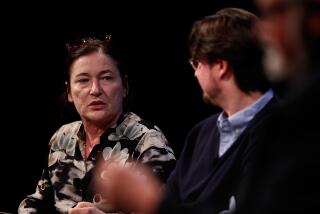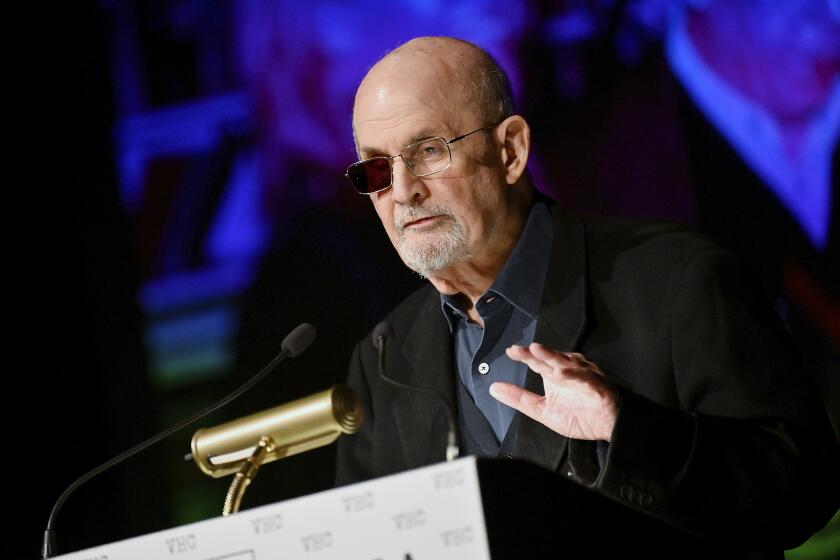Jules Feiffer dances with noir in his graphic novel ‘Kill My Mother’
Most octogenarians are slowing down, settling into the freedom of retirement — but not Jules Feiffer. Instead, the playwright, illustrator, screenwriter and Pulitzer Prize-winning cartoonist went back to the drawing board — literally — to tackle a whole new art form: the graphic novel.
“Never having known how to work in this style, suddenly in my 80s, I discover I can,” he says by phone from his home on Long Island, N.Y. “I was both shocked and appalled that I had assigned myself this 2½-year job of drudgery. It turned out to be fun, but at the time I thought, ‘This is impossible, what am I doing?’”
The result is his new graphic novel, “Kill My Mother” (Liveright: 160 pp., $27.95), a noir tale of dames and drunkards, wannabes and heroes, animosity and motherhood. It leans an elbow on the bar of the classics of pulp fiction and film: The story takes place in Bay City, a Raymond Chandler locale; a fight includes a line from “The Maltese Falcon”; and some very bad things happen in Dietrichson Park, named for Barbara Stanwyck’s character in “Double Indemnity.”
For more than 50 years, Feiffer has been the nation’s cool creative older brother — charming, slightly cynical and a few steps ahead of the culture. In the rule-following 1950s, he questioned authority by satirizing the military in his comic “Munro,” which became an Oscar-winning short; in the 1960s, he analyzed analysts, celebrated bohemians and eventually prodded hippies with his quavery-lined editorial cartoons in the Village Voice; in the 1970s, he took the sexual revolution to uncomfortable extremes with “Carnal Knowledge,” which he scripted.
Movies were a big influence on “Kill My Mother,” as were the other pop culture influences he was taking in before he began creating his own. “It returned me to a love I had of adventure comics and mysteries and noir that I’ve had since even before I was a teenager, stuff that I adored,” he says. “Going full circle in your dotage is nothing but fun.”
When asked if he is really in his dotage, he laughs and assures, “I am in full dotage.”
“Kill My Mother” was the first time in his seven-decade career he’d tried to capture the filmic imagery of noir on paper. “All noir demands street scenes, cars at night with headlights, pouring down rain,” he says. “I knew that I had to do that, I just didn’t know how I was going to craft it, how I was going to make it look convincing. Learning how to do that, figuring it out, was both scary and very exciting.”
Yet there’s more to “Kill My Mother” than (entirely delightful) noir nostalgia; it has a tightly built, surprisingly contemporary plot and a style all its own. Feiffer’s lines, as always, tremble, or perhaps vibrate is better — the story drives ahead with washes of grays and light yellows that evoke a black and white film plus a little extra. There is almost constant motion.
“Whenever I get a chance to dance on paper, I adore it,” Feiffer says. He did this with the modern dancer who regularly appeared in his editorial cartoons; most of the characters in “Kill My Mother” are fleet-footed, including a boxer called the Dancing Master.
And there’s more dancing in his charming new children’s book, “Rupert Can Dance” (Michael di Capua/Farrar, Straus and Giroux: 32 pp., $17.95, ages 3-6), about a girl and her cat who both dance. His East Hampton house has two cats — an older one, whose tail he pulls, and a younger feral adoptee who flirts but keeps her distance.
Before moving to the Hamptons, Feiffer lived in New York City for more than 50 years. “Four or five years ago I found that the city was no longer lovable because it had outlasted me,” he says. “I could not walk the way I used to, I couldn’t hear the way I used to, and basically all the things that made the city possible and exciting and a stimulating place to be now made it oppressive.”
Born and raised in the Bronx, Feiffer got his start as a teenage apprentice to cartoon legend Will Eisner, then was drafted into the Army. After he got back, he offered his cartooning services to the newly established Village Voice, which at first paid him nothing.
When he remembers those days in the 1950s his Bronx accent slips out — he was living on the second “floh-wah” (floor) in Brooklyn Heights when he met his downstairs neighbor throwing out the garbage. They became roommates and Feiffer’s friend, procrastinating, read a story he was writing aloud, and Feiffer began to draw.
“He never asked me to illustrate and I never thought about doing it, it just evolved — he took it for granted and I took it for granted. That’s how it came about,” Feiffer says. “He” was Norton Juster, and the result of their unplanned collaboration was “The Phantom Tollbooth,” the now-classic children’s book.
“Any real children’s book editor would have said: too many words, too complicated, kids won’t like it, they won’t understand it, this is not a kids book,” Feiffer says. “It’s just one more example — as if we need these examples — if you believe the experts you almost always get into trouble.”
Skepticism is an essential component of how Feiffer views the world. His older sister was a communist (dramatized in his play “The Bad Friend”) who was disappointed he didn’t turn out to be party material; a cousin was red-baiting Joseph McCarthy aide Roy Cohn. Between those poles, questioning authority may have been the only sane choice. When his Village Voice cartoons became a venue for his social conscience, he was willing to cast a critical eye at the Left, the Voice’s audience.
He is now — at 85 — at work on the “Kill My Mother” sequel, which will actually be a prequel. He hopes his editor likes it. “I’m living in a house with a swimming pool for the first time in my life, and I want to keep it,” he says.
“I’m a lousy swimmer,” he continues, laughing, “so I’m afraid if I go into the pool over my head I’ll drown. I used to be 6 feet one-quarter inch and now I’m 5-foot-10.” Another hazard of age. But he’s OK with that, and then some.
“If I go on the way I hope to,” he quips. “I’ll be only 5 feet.”
Like passing notes in class; I’m @paperhaus on Twitter
More to Read
Sign up for our Book Club newsletter
Get the latest news, events and more from the Los Angeles Times Book Club, and help us get L.A. reading and talking.
You may occasionally receive promotional content from the Los Angeles Times.







